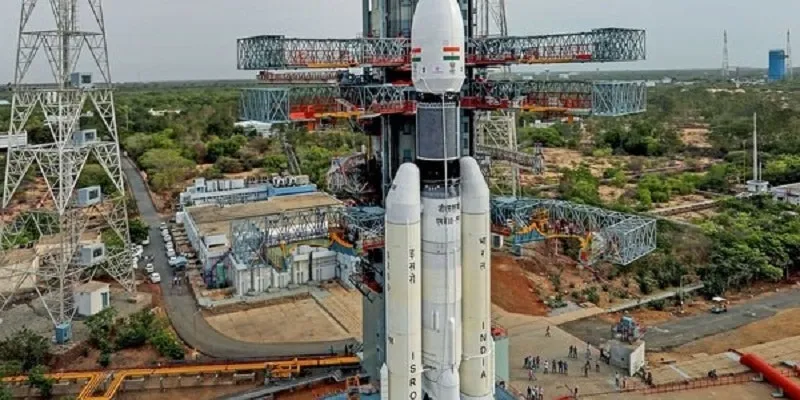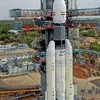Chandrayaan-2: a successful launch will give India a strategic advantage
The Chandrayaan-2 mission demonstrates ISRO’s capability to fire powerful rockets, carry heavy payloads, navigate in space, perform complex procedures, and showcases expertise in signaling and communications, cartography, sensor technology, and chemistry.
Chandryaan-2 is set to lift off a couple of days after Neil Armstrong and Buzz Aldrin walked on the moon, 50 years ago. I find it both, ironical and poetic. As if India is inheriting the task of mankind, to push the boundaries, and write the next chapter in human history.
Chandrayaan-2 is another accomplishment in a series of long accolades for ISRO. These include Chandrayaan-1 in 2008, the Mars orbiter in 2014 (making Indian the fourth country in the world and the first Asian country to reach Mars), and Chandrayaan-2, which will be followed by Gaganyaan (India’s first manned mission in 2022).

Image: PTI
Chandrayaan-2 is expected to lift off at 2.43 pm on July 22. This is India’s second lunar moon mission, and includes a lunar orbiter, a lander (Vikram), and a rover (Pragyaan). The made-in-India craft is expected to land on the moon’s south polar region. The successful touchdown of Vikram and Pragyaan on the lunar surface will propel India into an elite club; it will make us the fourth country to have achieved the feat after the former Soviet Union, US, and China.
The craft is carrying payloads that will carry multiple data-gathering experiments, from ranging and mapping to mineral exploration. Most important is the exploration of water (Chandrayaan -1 detected water molecules).
A tactical advantage
Chandrayaan-2 is an engineering marvel. It demonstrates ISRO’s capability to fire powerful rockets, carry heavy payloads, navigate in space, perform complex procedures, and showcases expertise in signaling and communications, cartography, sensor technology, and chemistry.
More so, the strategic advantage that it gives India needs to be acknowledged. Space is getting militarised. France and the US already have a space command. On March 27, 2019, India successfully tested an anti-satellite weapon (that irritated the Americans). Chandrayaan-2 proves that India can have equipment far way in invulnerable space (actually, theoretically as far as the moon).
In the future, India could add space to its nuclear triad. The option is now open, and the country is gaining control over the ultimate higher ground.
Race to the moon
As countries compete, the moon will be treated like any other geography that needs to dominated. And it’s getting crowded. The US has launched Project Artemis (the successor to the Apollo moon missions). Donald Trump, the President of the US, has set 2024 as a deadline to a man (or may be a woman) back on the moon. Elon Musk and Space X are also targeting the same dates. The Chinese are not too far behind; they have already landed a probe on the far side of the moon. They are looking at a research station on the South Pole of the moon and a permanent manned presence by 2030s.
The moon is the first step in the colonisation of space. Moon’s thin atmosphere and low gravity is being seen as a launch pad for further space exploration, especially Mars and may be even Europa (Europa is Jupiter’s fourth largest moon. Its geophysical features, including possible sub-glacial water, make it a distinct possibility for human colonisation).
The discovery of water molecules by Chandrayaan-1 and further exploration by Vikram and Pragyaan can help figure out the closed loop. Can water and other minerals on the moon be used to fuel rockets and sustain life somewhat independently? This seems to be the reason that the Chinese are reaching for the South Pole (possibility of high concentrations of ice). The race for space colonies has started, and the biggest squatter in the moon will win. India has a lead, and is perpetuating it.
Together we can
I am also amazed by the strategic vision of the political class. Despite being a fractious political system, our leaders have always had one unified vision for space. India has a very strong sense of her manifest destiny. There is no dilution in India’s space narrative irrespective of a churn in leadership. ISRO’s plans have transcended leadership change from the UPA to NDA seamlessly. And credit should be given.
A lot is said about the cost of the project, estimated at about Rs 978 crore or approximately $142 million. Just to give you a sense, the latest Disney movie Avengers: Endgame cost $700 million to produce.
But this is something that I am uncomfortable with. If India/ ISRO is solving such complex problems in aerodynamics, material sciences, computing, cartography, chemistry, and sensors at such a low per unit cost, then why are these advantages not being passed on to private industry? Why are we not the cheapest producer of 5G equipment, cubesats, jet engines, sensors, and solar panels? A version of the listed technologies has probably been worked in Chandrayaan-2. We really need to address these peculiar lacunae. India needs to tweak her narrative. We need to mandate spin-offs.
And this brings me to Team Indus, a Delhi/Bangalore-based company that won an interim award of US$1 million (Google Lunar X Prize) for their successful demonstration of a proposed lunar landing system. There were talks about working with ISRO that came to naught. Today, Team Indus has been engaged by US-based OrbitBeyond [the company was selected to bid robotic lander contracts from NASA's Commercial Lunar Payload Services (CLPS)].
Imagine if Team Indus had piggybacked on Vikram? May be we could have had two rovers. And Team Indus would be the first private space company in the world to reach the moon. Imagine what it would have meant for India’s nascent space industry. Not only can India lead in space technologies, we can become a magnet for innovation and capital from around world. Instead we make peace with becoming venerable outsourced agencies.
Chandrayaan 2- belongs to all of us. If we dream together, why can’t we work together?
(Disclaimer: The views and opinions expressed in this article are those of the author and do not necessarily reflect the views of YourStory.)
(Edited by Teja Lele Desai)









